All about SEO Copywriting in 2023
In this guide, Brandfirm breaks down everything you need to know, in uncomplicated terms, about SEO Copywriting in 2023. With this guide within reach, SEO Copywriting is made simple.

After reading this article, you learned:
- What SEO copywriting is
- Why SEO copywriting is so important
- How to do keyword research
- How to correctly process the keywords in a text
- What to do with duplicate content
- How to measure the results of your SEO content
In this article
1. Introduction to SEO copywriting
First, let's get back to basics. Before you start writing SEO content, you need to know what SEO copywriting is.
What is SEO copywriting?
SEO copywriting refers to writing texts that, through search engine optimization, are easily found on Google. This type of SEO content is not only attractive to Google but is written in a way that makes the text appealing to consumers. Since no matter how well you do on Google, your most important goal should be that customers choose your service or product.
In a nutshell: SEO copywriting is writing texts that Google ‘gets’ and at the same time engages potential customers.
If you only write SEO content for search engines, the text is not appealing to users landing on your page. We naturally want to avoid this. Yet, when you write content only intended for the user, you may not use the right keywords, making the text virtually invisible in search engines. So a fine balance is needed between the needs of the search engine and those of the consumer. This is what you’ll learn in this guide.
Old-school versus modern SEO copywriting
Old-school SEO copywriting:
In the early days of SEO copywriting, keywords had to appear as often as possible in texts. This made texts poorly readable and uninviting.
Suppose you wanted to write an SEO text with the keyword "black faucet," an old-school text would read:
"This faucet black suits the modern bathroom." or "Looking for a gorgeous faucet? Black is the go-to color right now."
Modern SEO copywriting:
Nowadays, texts should also be easy for the user to read.
We are still using keywords, but we weave them naturally into the text. For example, we still mention the keyword, but only 2-3 times per 250 words. We also use Google-friendly headers and more and more keyword synonyms.
An SEO text about the keyword "black faucet" is more likely to look like this in 2023:
"The black faucet is here to stay. Where at first we were worried that black faucets were a fad, the faucet has now proven to be timeless, modern, and well-loved."
This is user intent (and why it matters)
Before you get started with SEO copywriting, it’s important to find out the user's intent. User intent is a user's reason/motivation for googling a specific keyword.
Once you have this information, you can apply SEO to your website's content. User intent is important because it tells you what your target audience is searching for. But that's not all, you also know how they're searching for it.
For example:
Let's say you own a hair salon that specializes in styling curly hair. You know that your target audience is curly-haired people looking for a hairdresser that is particularly good at cutting curly hair. Chances are, your target audience will type the following phrases into a search engine: 'hairdresser for curls,’ ‘curly hairdresser,’ ‘hairdresser specializing in curls,’ ‘hairdresser for curly hair.’ Now you know your target audience's user intent, you can start using this in your SEO copywriting.

There are five types of user intent:
1. Informational user intent: the user wants more information about a specific topic. These are often questions that begin with: what, which, how, who, or when. For example: "How are leather footballs made?"

2. Commercial user intent: the user is looking for a specific product or service. If the consumer already knows what they’re looking for, they are more likely to make a purchase. For example: “leather football Nike”

3. Orienting user intent: the user is looking for advice before they make a purchase. They often search for the pros and cons of a particular product. Lists with, for example, ‘top 10 best products’ also do well with this user intent. For example: “best leather football”

4. Transactional user intent: the user wants to convert immediately. For example: "order leather football"

5. Local user intent: the user is looking for a business nearby that can help them find information about or purchase the product. For example: "soccer store Amsterdam"

What does Google want from SEO copywriters?
SEO content is important for good organic search results and drives more organic traffic to your website.
So what does Google want from SEO copywriters?
Rich content
When Google labels your text as rich content, you are on the right track. Rich content means:
- Texts of at least 500 words (the more words, the more "rich" Google deems the content and the better you rank)
- Texts with internal and external links with matching anchor texts (internal links are links to other pages on your website, external links are links to other websites)
- Text with headings (H1, H2, H3, etc.) and images that break up the text
- Short paragraphs that make the text easy to read and accessible to the user
Keywords woven naturally into the text
Google wants SEO content to have the right keywords. However, these keywords must be woven into the text intuitively. This makes sure the text is easy to read. We’ll explain how to do this later in this chapter.
The text must have good technical SEO
This means that the meta title, meta description, ALT text, and URL should be organized as favorably as possible and contain the keywords you identified in the keyword research.

In the next chapter, you'll learn all about doing keyword research. Practical tips on the technical aspect of this form of copywriting can be found in Chapter 3.
Natural language processing
As explained previously, it's important to incorporate the keywords from your keyword research into your copy intuitively.
After all, SEO content is important for Google, but also for the user. Therefore, keep in mind that the SEO tips & tricks you are going to learn in this guide should never come at the expense of your text’s readability.
Try to incorporate these guidelines into your copywriting as much as possible, but when you can't, don't force it.
Google will judge you for that, and so will the user for that matter.
Practical tips for incorporating keywords naturally:
- Make sure your keyword density is 1%. This means that your chosen keyword - also known as the focus keyword - appears in the text 1% of the time. This is about two to three times per 250 words. Then again, if you can't (and don't want to) mention the keyword that often, it's better to opt for a lower density. Conversely, if you can naturally incorporate it more often, that's also okay. The important thing is that the text is clear and easy to read.
- Use synonyms of keywords, too. For instance, don't just write about jeans, but also mention the words blue jeans or denim.
- Make sure sentences are grammatically sound. Most keywords are short and targeted (such as "buy leather football"). Therefore, it’s important you incorporate these keywords correctly. You can add a prefix or article to the keyword if necessary. This is less beneficial to search engines but makes the SEO content pleasant to read.
We answered the question, "What is SEO copywriting?", so now we'll move on to a crucial part of SEO copywriting: keyword research.
After all, you can't write good SEO content without keywords.
Request our free SEO copywriting analysis
- Gain insight into opportunities for SEO
- This takes us at least 4 to 6 hours of work
2. Coming up with a keyword strategy
As you may have gathered from the previous section, keywords are key for SEO copywriting.
That's why we'll tell you all about them in this chapter. From doing keyword research to choosing the right keywords.
Here's why keywords are crucial
The reason keywords are necessary for copywriting is that people use them for their searches in search engines.
As a business, you want to respond to user searches by incorporating these keywords into your copy.
If you don't, your website won't appear in the SERP when a user enters a search query and potential customers won't come across your business.
How to conduct keyword research
You can conduct keyword research in many different ways, and most SEO copywriters have their own methods.
Fortunately, there are many useful (and also free) online tools that can perform keyword research for you.
We’ll take a look at two handy websites: Answer the Public and Ubersuggest by Neil Patel.
Answer the Public
The free tool Answer the Public is perfect for creative keyword research.
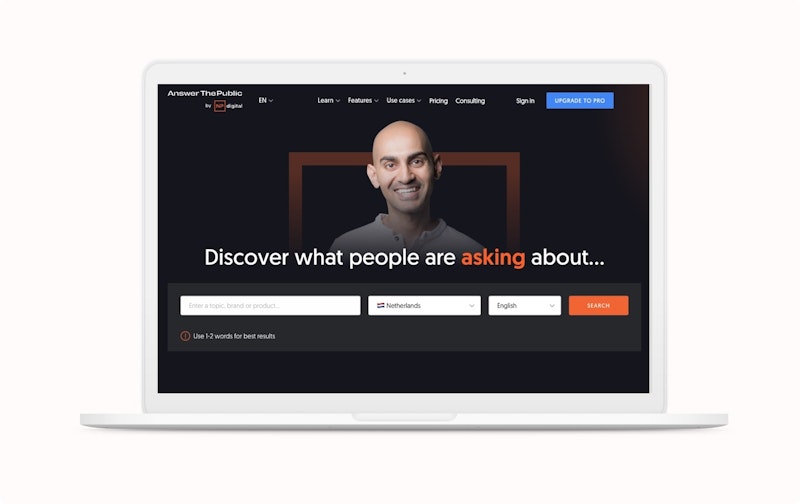
If you don't yet know exactly what your target audience is looking for on Google, it's best to start with broad keyword research on this website.
Here you can explore two keywords per day for free. If you choose the paid version, you can research an unlimited number of keywords in one day.
Here's how Answer the Public works:
- Enter a wide-ranging keyword you'd like to learn more about. For example: ‘football.’
- Select the desired country and language

When the search results finish loading, a word web appears with all kinds of terms. To organize the data, click on the 'Export icon'.

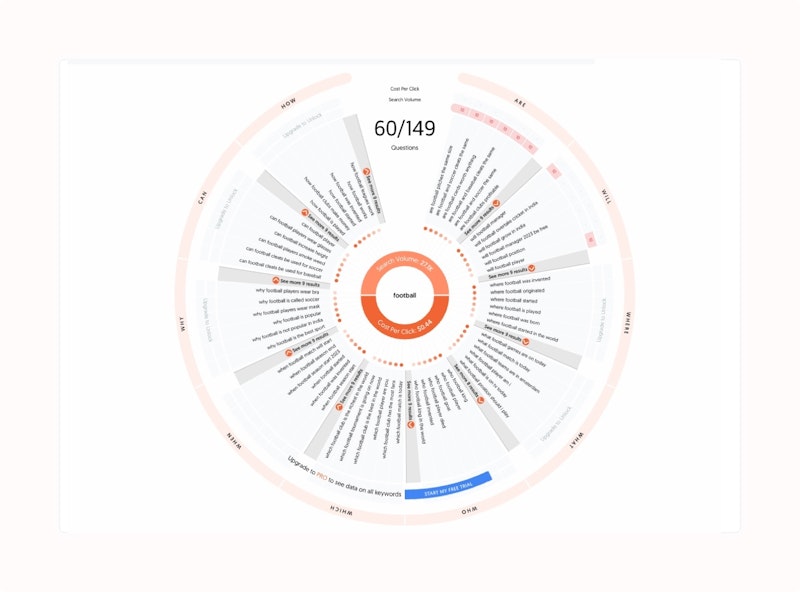
In the downloaded table you will find suggestions of various how, where, which, what, and who questions (for example: how to inflate a football). But also a list of prepositions, such as: at, with, to, for, without, as (for example: football with rope). You will also find a list of comparisons with the words and, or, equal, and versus (for example: soccer or skating). Finally, you will see a list in which keywords related to ‘football’ are in alphabetical order.
Good to know: this list does not indicate the search volume of these keywords, nor does it tell you how much competition there is for a particular keyword. You can carry out this keyword research to find inspiration for a website text. To know exactly which keyword is best to use, turn to Ubersuggest. You can then upload your keywords into Google's free keyword planner as well.
Ubersuggest by Neil Patel
Ubersuggest is a handy tool that lets you measure the search volume and competitiveness of specific keywords.

You’ll also find helpful keyword suggestions that match the keyword you entered.
If you use the free version, you can enter five keywords per day. If you choose the paid version, the number of keywords is unlimited.
Here's how Ubersuggest works:
- Enter a somewhat specific keyword for your text. For example: ‘leather football’
- Select the language and location you want to search for
- A screen will appear with all kinds of numbers and colors (see screenshot below)
- You will see keywords similar to the one you entered, such as ‘leather footballs,’ ‘old leather football’ and ‘buy leather football’
- As with Answer the Public, you can download the results in an Excel document by clicking on 'Download CSV' (to do this, first click on 'Display all keyword ideas' below the table)

This is what the data in Ubersuggest's table means:
Vol: search volume per month. As you can see, ‘leather football’ is searched 590 times per month.
CPC: cost per click, this is an estimate of the approximate amount you’ll pay when setting up a Google Ads campaign. For SEO copywriting, we don't need to look at this.
PD: paid difficulty. This is an estimate of how tough the competition is for paid searches. The higher the figure, the more competition there is. This figure is only interesting if you want to set up a paid ad with this keyword. For SEO copywriting, we’ll also skip this column.
SD: SEO difficulty. This number is an estimate of the organic competition for this keyword. This is a very important figure because you will use this figure in your choice of keyword for your SEO content. The higher this number, the greater the competition.
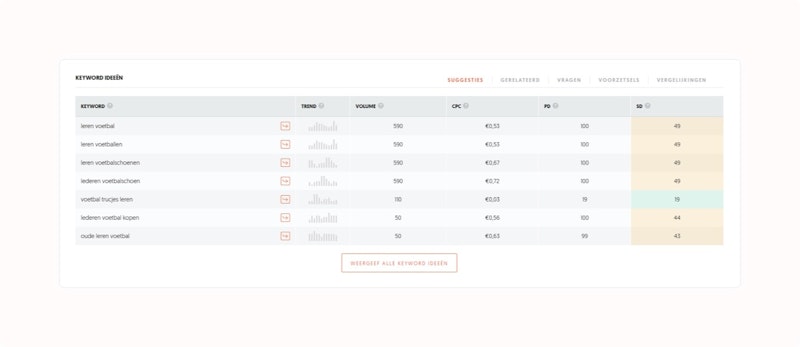
Request our free SEO analysis
- A free analysis worth 4 to 6 hours of work
- 87% of the companies we analyze miss out on sales
How to select the right keywords for your SEO content
Now that you have a list of keywords, how do you know which ones will rank best in Google's SERP?
That's what we're going to outline in this section. To select the right keywords, you need your keyword suggestions, the search volume per month, and the level of competition.
Long-tail keywords
In general, long-tail keywords rank higher on Google. Long-tail keywords are long and specific keywords that add a bit more to the general keyword.
The reason these keywords work better is that they are specific and have a lower level of competition. Because they’re more specific, your chosen keyword is also more likely to match the user's search query.
Because there is less competition for a long-tail keyword, you are more likely to end up higher in the SERP and will be more visible to users.
Example of a long-tail keyword: 'leather football Nike'
Example of a broad keyword: 'football'
Characteristics of a focus keyword
Choosing the right keywords is important for SEO copywriting. Keywords are the building blocks of the SEO content on your website.
You can include several keywords in your text, but your text will only really grab the attention of search engines if you highlight one keyword.
This specific keyword is called the focus keyword.
The focus keyword should be:
- A keyword where the search volume per month is as high as possible
- A keyword where the competition is as low as possible (the SD preferably below 30)
- The word covers the scope of the landing page the user lands on (the focus keyword must be consistent with the purpose and content of the text)
- A long-tail keyword
Take a look at your list of collected keywords and select the keyword with the right balance between a high search volume per month and low competition.
It may be that the market for ‘leather football’ is hugely competitive or yet entirely unknown.
A competition number below 30 is ideal, but if you don't have a choice (because otherwise, you have a search volume of 0 searches per month, for example), you can select a keyword with a higher search volume per month, but also slightly higher competition.
The key is to find the right balance.
Synonyms, plurals & singulars
In 2023, it has become increasingly important to incorporate variations of your focus keyword. To this end, use both singulars and plurals ("leather football" and "leather footballs").
After all, Google is getting smarter by the minute. The search engine knows how to detect synonyms of keywords. We gave you the example of jeans earlier in this guide.
To illustrate, it would be beneficial to include the words blue jeans and denim in your copywriting as well.
Now you’ve read this chapter, you know all about doing keyword research and can decide on a focus keyword. You know what requirements this focus keyword must meet and you can naturally incorporate this keyword into the text.
In the next chapter, we'll give you even more practical tips & tricks on how to write SEO content.
Receive our newsletter
- +5,000 entrepreneurs preceded you. We share our knowledge for free.
3. SEO copywriting techniques you can put into action
You now know how to naturally incorporate keywords into a text, but the technical back end of search engine optimization may still be uncharted territory for you.
Soon, however, you’ll find out all about Google-friendly headers, link building, and well-organized meta titles.
Google-friendly headers
SEO copywriting is all about finding a balance between writing for Google and writing for the user.
Google-friendly headers are an excellent example of this.
By using different headers (H1, H2, H3, etc.) the keywords you use in these headers catch Google’s attention. But these headers also work well for the user reading the text.
Here's how to create Google-friendly headers:
- Use both H1, H2 and H3 headers
- Incorporate your focus keyword at the beginning of H1
- Incorporate all other relevant keywords from your keyword research in (and at the start of) your H2 and H3 headers
Bonus tip: use your keyword research as a guideline for the rest of your copy. Say you're writing a blog about ‘leather footballs’ and you also come across the keywords ‘football sale’ or ‘football repair’ in your keyword research. You can write a separate paragraph for both keywords in which that keyword is mentioned several times. Consumers can then find you on Google for those terms as well.
Internal links and anchor texts
Internal links and corresponding anchor texts allow you to craft good SEO content.
If you’re familiar with SEO, you may already know that Google needs internal links to discover new pages. When you add a new page to your website (for example, a blog about 'leather footballs'), Google is more likely to detect it if you link to the new page on an existing page.
This is also known as link building.
You can optimize link building by using anchor texts. An anchor text is a phrase that is used to link to an internal page.
A mistake copywriters often make is using the phrase ‘click here’ to link to internal pages. However, Google is smart enough to link the anchor text to the title of the new internal page. And it wants these two to match.
For example: you want the general category page with soccer products to also link to your new page about leather footballs.
You can link to your new page like this: 'Click here for more information about leather footballs' (with the link under 'click here').
Or: "We also offer leather footballs" (with the link under ‘leather footballs’).
The second example provides better results in the SERP because Google rates a targeted anchor text better than a generic anchor text that does not match the title of the relevant landing page.
Meta titles and descriptions
Meta titles and descriptions are equally important to Google. These are displayed in Google's SERP and persuade users to visit your website.

Meta title: the title you see in the organic search results.
- Has a maximum of 60 characters
- Contains the focus keyword (preferably at the start of the sentence)
- Contains your company name with a hyphen or delimiter
- Preferably includes a CTA (call to action)
- For example: Looking to buy a leather football? Check our offer here | Soccer Store
Meta description: the description that appears in the organic search results
- Has 120 to 158 characters
- Contains the focus keyword (preferably at the start)
- Also contains other keywords from your keyword research (or variations of the focus keyword)
- May also include your company's name, but this is not a requirement
- Ends with a CTA
- You can also add delimiters between short phrases. For example: Buy the best leather footballs here | Free shipping on orders over €50 | Check out our offer here
- For example: Looking for a leather football? At Soccer Store you will find the most beautiful leather footballs to use outdoors. Be sure to check out our wide range!
Want to know if you did it right? Enter the URL of the relevant page on ToTheWeb.com, here you can get free tips for a good meta description.
URL: the slug of the webpage.
- Contains the focus keyword
- Has the focus keyword at the start of the URL
- Is very specific (without prepositions, etc.)
- The shorter the better
- For example: soccerstore.com/leather-football
Featured snippets
These are highlighted search results that appear at the top of the SERP on Google. This happens, for example, when you type a question into the search bar. Since this featured search result is highlighted, it is very interesting for a company to capitalize on.
This is what a featured snippet may look like:

For featured snippets, you can make use of the questions you found when doing keyword research through Answer the Public. For instance, you can answer these questions in your content or in an FAQ (frequently asked questions) section on the page. Ideally, you place the question in a headline (H1, H2, or H3) and answer it in the paragraph below. With structured data, you can signify your FAQs to make it clearer to Google that they are FAQs.
Pay attention to this when answering questions:
- Provide short paragraphs and sentences
- Answer the question right away (don't beat around the bush)
- Use headings (H1, H2, H3) when you go deeper into the topic
- Include the question in the answer
- Summarize everything at the end in a conclusion
But featured snippets do not just contain questions; in fact, there are different types of snippets. They can include a summary of a process or recipe (roadmap), a numbered list (for example, the top 10 movies of 2023), a table with statistics, a paragraph in which a question is answered, or a preview of a YouTube video (with a tutorial, for example).
4. Persuasive writing for the user
The SEO content on your website should not only be optimized for Google, but the copy should also engage the user.
This means that your texts encourage the user to convert.
If your texts do well in search engines, you will attract more visitors to your website. Yet, you have to persuade them to buy.
You do this by using ‘power words’ and ‘framing’ in your SEO copywriting. We will share even more about this in a separate guide.
Using power words
Power words are words that subconsciously evoke an emotion or feeling in the user reading your texts.
These emotions make them more likely to purchase.
These are the most well-known power words:
- Because: research shows that people are more likely to help you or buy something from you when you give them a reason. Case in point: Every business owner should invest in good SEO copywriting because it makes your business more easy to find on Google.
- Tips: people love tips. You can use them in your headlines or Calls To Action. For example: 5 handy tips for snazzy SEO content
- Free: people love freebies. For example: Download my free e-book on SEO copywriting
- You: people are social animals that subconsciously look for validation. When you address them directly in your text, they have a sense of personal involvement. For example: With these tips, you can write your own SEO content
- Fast: Users want results as quickly as possible. Use words like ‘fast,’ ‘right away,’ ‘quick result’ or ‘within a day’ to show that you can solve users’ problems fast. For example: After reading this guide, you can get started with SEO copywriting right away.
- New: People feel triggered when something is new, so be sure to take advantage of that when you launch a new(er) product or service. For example: New! The 2023 SEO copywriting guide
Framing
Another trick to make your website copy appealing to visitors is framing.
With framing, you wrap your website’s content in a way that persuades the visitor without them realizing it.
To give provoke a feeling in the reader, you have to choose your words strategically.
Some practical tips on how to use framing in your SEO content:
- Use ‘discover’ instead of read/learn more. Subconsciously, we mark the words ‘learn’ and ‘read’ as tiresome. Discover, on the other hand, stirs our curiosity and makes us more likely to click.
- Choose a positive angle. To do this, use positive words instead of negative ones. For example, think of ‘feedback’ instead of ‘criticism’ or ‘challenge’ instead of ‘problem.’
- Respond to people's fear of being left out with, for example, a special offer. You can do this with phrases like ‘limited time only,’ ‘this week,’ and ‘now or never.’
- Be reassuring. Use positive stats and focus on good results to reassure the user.
5. SEO copywriting: dotting the i's and crossing the t's
You now know a lot about SEO copywriting, but the final steps in this chapter are hugely important if you want your content to be popular with search engines as well as users.
Google values brand mentions and links: here's why
Google loves links.
They are part of what makes Google pay attention to you at all, but that's not everything.
In fact, based on links and brand mentions, search engines determine how authoritative your business is. The more relevant internal and external links to your website, the higher Google will rank you.
Links prove that you know what you’re talking about and are trustworthy. In SEO jargon, we call this link building.
You can apply link building in these ways:
- Provide internal links on your website: the more links point to a specific page on your website, the higher this page will be rated.
- Add external links to your website. You can boost this in these ways:
- When someone interviews you about your business, make sure they link to your page in their texts.
- Share blogs on social media with a link to your website
- Write engaging texts that the user feels compelled to share (such as free tips etc.)
- General rule: all links must be relevant! It makes no sense to randomly place links under random words in your texts. Use matching anchor texts for the best SEO results.
What is duplicate content?
Duplicate content means having the same text on different pages.
This can happen within one website or on different websites.
With duplicate content, search engines show only one of the two pages, which in the worst-case scenario means that your page will not be visible in the SERP.
For example, if you want to copy a press release, never copy the text verbatim.
Here's how to solve duplicate content:
- Provide unique SEO content
- Use an HTML rel='canonical'-tag: this shows that the content is actually from another source. This does mean that when someone searches for this information, they will not come to you, but to the original source. Your canonical is not visible in search engines.
- Increase your company’s authority with good content and backlinks (external links to your website).
- 301-redirects: when a user enters the URL of a duplicate page, they are redirected to the original source.
6. Measure your SEO content’s performance
Data is important. So is SEO copywriting.
It's useful to keep an eye on whether all the tips and tricks you've applied to writing your conversion copy are really working.
You can do this by using Google Search Console and CognitiveSEO. We'll take a look at both.
Measuring keywords with Google Search Console
Google Search Console gives you insight into how well you optimized your website for search engines.
It shows you the average position of your page when a search is submitted using your focus keyword, and you can enter the URL of a page to see how well it ranks on Google.
Here’s how you can identify the searches that brought the most visitors to your website:
1. In the menu on the left, click on Search results
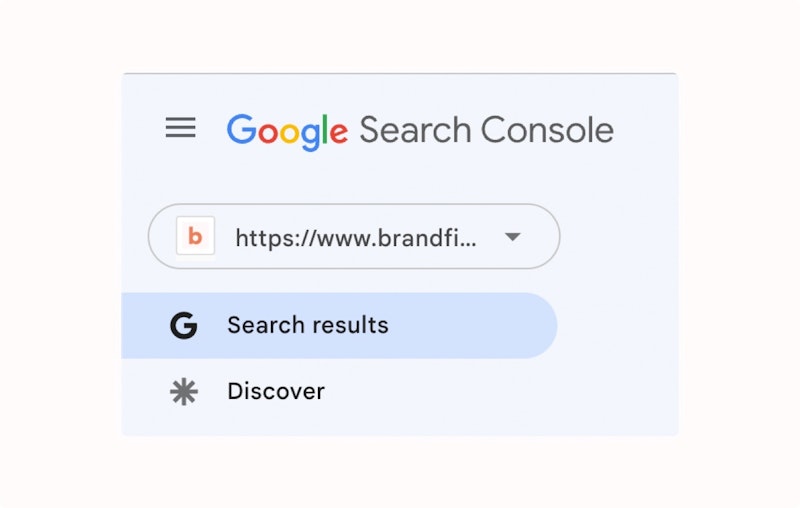
2. Under the graph, click on the 'Queries' tab.
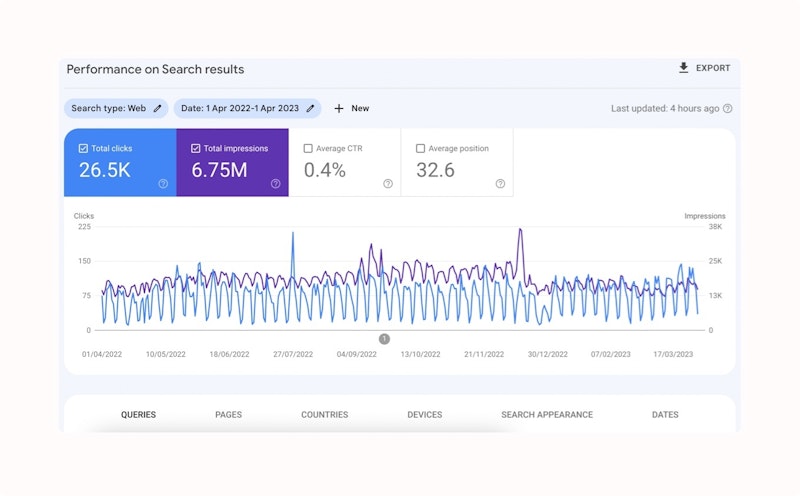
3. At the top of the page, select the dates you want to use
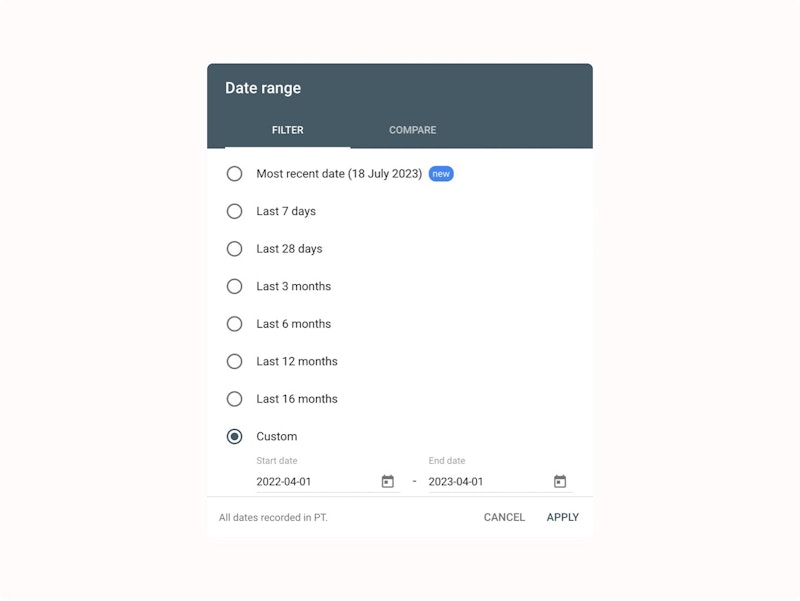
4. Navigate to ‘Clicks’

5. Click on the arrow next to 'Number of clicks' so that the keywords with the highest number of clicks appear at the top.
Google Search Console lets you measure, for free, which keyword drove the most traffic to your company's website in a given period.
Measuring keywords using CognitiveSEO
You can also use a paid tool to measure SEO performance.
This allows you to measure exactly how well your focus keyword, which you have carefully incorporated into your content, actually does in search engines.
CognitiveSEO gives you insight into the following data for a specific page:
- Content performance: how relevant and optimized the content is, based on the focus keyword. Approximately how high your page ranks in Google's SERP.
- Readability score: this score indicates how readable the text is for the user. The higher, the better
- Focus keywords: this number indicates how much you can still optimize your keywords. This can be done by following CognitiveSEO's specific instructions

7. These are the 5 SEO copywriting trends of 2023
1. Updated Core Web Vitals. These are the requirements a website or page must meet to rank highly in the SERP. In 2023, not only is the quality and relevance of content key but the user experience is also included in a search engine’s assessment. Among other things, this is measured by the page load time and how fast ads and images load in contrast to the rest of your content. In other words, it’s crucial to optimize in 2023.
2. Quality, reliability, and authority are becoming increasingly important. In 2023, the focus is truly on the quality of content posted online. By now, technology has developed to the point where just about anyone can write something on a given topic. Google will therefore regard you more highly this year if you develop expert status. You can do this by using reliable sources and being transparent about who you are.
3. Shift the focus from keywords to topics. We often optimize a page based on the focus keyword, but we're going to let go of this a bit more in 2023. Instead of having the keyword 'leather football' come back in numerous places in the text, use synonyms and variations. Such as ‘football made of leather,’ and ‘leather ball,’ etc.
4. Longer content performs better in the SERP. Research has demonstrated that texts with more than 3,000 words attract three times more visitors than shorter texts. Therefore, in 2023 it's a good idea to supplement your pages with extensive and relevant information on the same topic.
5. Write for mobile users. The majority of users read texts on their phones and this percentage will only increase in 2023. Make sure pages are optimized for mobile use, which includes fast load times and short paragraphs.
8. Conclusion
Once you have these tips & tricks under your belt, you’re ready to hit the ground running with SEO copywriting that is both technically sound and pleasing to the reader.
In this copywriting guide, you've learned:
- That SEO copywriting is writing engaging content for search engines and the user
- That the user intent of the visitor is important for search engine optimization because it allows you to respond to the user’s needs
- That 'rich content' is content of around 500 words with relevant headers, internal links, and short paragraphs
- Keywords are important for SEO copywriting because they help users find you
- You can do keyword research by using Answer The Public and Ubersuggest
- A good focus keyword is a long-tail keyword with a high search volume per month and low competition
- What technical requirements SEO content must meet (think meta title, meta description, and URL)
- That featured snippets have a highly valuable position in Google's SERP. You also know that by answering frequently asked questions and working with a roadmap you can get featured snippets.
- That your SEO content should be appealing to the user and not just optimized for search engines
- Which power words are interesting to use in your texts
- You can use framing to subconsciously persuade users to buy your products.
- How to use link building for better SEO content
- How to avoid duplicate content (but also what to do if it happens)
- How to measure your SEO performance with Google Search Console and CognitiveSEO
We're eager to hear your opinion.
What tips from this guide will you put to use first? Or maybe we haven't mentioned an important SEO tip yet.
Let us know by commenting below. Or share your comment on social media. Need help from a digital agency? Do not hesitate to contact us or request our free analysis.
Request our free analysis.
- A free analysis worth 4 to 6 hours of work
- Clear custom-made strategy
- 87% of the companies we analyze miss out on sales

